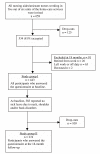Sick leave among home-care personnel: a longitudinal study of risk factors
- PMID: 15533255
- PMCID: PMC539270
- DOI: 10.1186/1471-2474-5-38
Sick leave among home-care personnel: a longitudinal study of risk factors
Abstract
Background: Sick leave due to neck, shoulder and back disorders (NSBD) is higher among health-care workers, especially nursing aides/assistant nurses, compared with employees in other occupations. More information is needed about predictors of sick leave among health care workers. The aim of the study was to assess whether self-reported factors related to health, work and leisure time could predict: 1) future certified sick leave due to any cause, in nursing aides/assistant nurses (Study group I) and 2) future self-reported sick leave due to NSBD in nursing aides/assistant nurses (Study group II).
Methods: Study group I, comprised 443 female nursing aides/assistant nurses, not on sick leave at baseline when a questionnaire was completed. Data on certified sick leave were collected after 18 months. Study group II comprised 274 of the women, who at baseline reported no sick leave during the preceding year due to NSBD and who participated at the 18 month follow-up. Data on sick leave due to NSBD were collected from the questionnaire at 18 months. The associations between future sick leave and factors related to health, work and leisure time were tested by logistic regression analyses.
Results: Health-related factors such as previous low back disorders (OR: 1.89; 95% CI 1.20-2.97) and previous sick leave (OR 6.40; 95%CI 3.97-10.31), were associated with a higher risk of future sick leave due to any cause. Factors related to health, work and leisure time, i.e. previous low back disorders (OR: 4.45; 95% CI 1.27-15.77) previous sick leave, not due to NSBD (OR 3.30; 95%CI 1.33-8.17), high strain work (OR 2.34; 95%CI 1.05-5.23) and high perceived physical exertion in domestic work (OR 2.56; 95%CI 1.12-5.86) were associated with a higher risk of future sick leave due to NSBD. In the final analyses, previous low back disorders and previous sick leave remained significant in both study groups.
Conclusion: The results suggest a focus on previous low back disorders and previous sick leave for the design of early prevention programmes aiming at reducing future sick leave due to any cause, as well as due to NSBD, among nursing aides/assistant nurses. A multifactorial approach may be of importance in the early prevention of sick leave due to NSBD.
References
-
- The National Social Insurance Board http://www.rfv.se/publikationer/pdf/red0203.pdf (in Swedish)
-
- Cohen-Mansfield J, Culpepper WJ, II, Carter P. Nursing staff back injuries. Prevalence and costs in long tem care facilities. AAOOHN J. 1996;44:9–17. - PubMed
-
- Alexopoulos EC, Burdorf A, Kalokerinou A. Risk factors for musculoskeletal disorders among nursing personnel in Greek hospitals. Int Arch Occup Environ Health. 2003;76:289–294. - PubMed
Publication types
MeSH terms
LinkOut - more resources
Full Text Sources
Medical


